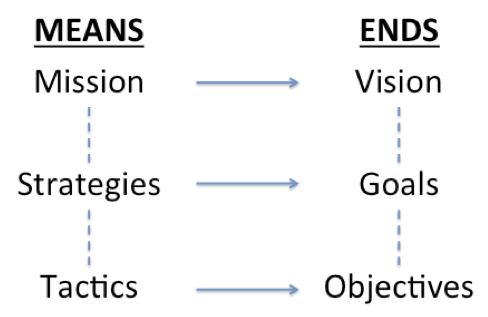Every time I hear someone say, “I’m not clear on our vision”, chills run down my spine. For people who just want to get things done, debating mission, vision and strategy seems like a grand waste of time. Life’s too short to waste it navel gazing! But for others, life is too short to waste on meaningless activity. Work must have a purpose beyond financial compensation.
If that purpose isn’t clear, how do they know they’re working on the right things?
Over the years I’ve been involved in countless strategic planning exercises in which good people struggle valiantly to define a common future. In some cases the process works and in others the outcome ranges from pleasant team-building to total waste of time. Since most organizations spend a lot of effort on strategic planning, it makes sense to figure out how to do things right.
Here’s the best tip I can give you: start by agreeing on terminology.
At least half the challenge with strategic planning is that people don’t ensure that they are using a common language. For example, what’s the difference between a “mission” and a “vision” for your organization? And really, how do you distinguish a “strategy” from a “tactic”? If the language isn’t clear, the strategic planning process is at risk, right from the start.
Strategic discussions address two primary topics: ends (what we want to achieve) and means (how we’re going to achieve it). So, a vision is an enduring statement of the way you want the world to be. A mission is a broad statement of how you’re going to get there. Once you’ve locked this in, the rest of the lexicon of strategic planning falls into place underneath, in subsequent layers of supporting detail:
A vision is elaborated in multiple goals that are, in turn, each itemized into specific shorter-term objectives. Similarly, the mission is implemented through multiple strategies, each of which is further enacted through shorter-term tactics. Strategies are followed to achieve longer-term goals. Tactics are implemented to meet shorter-term objectives. It is simply amazing how helpful it is to know whether you’re talking about results (vision/goals/objectives) vs. actions (mission/strategies/tactics) when you’re in the heat of a strategic debate!
You might disagree with the definitions in this framework. That’s fine. Just make sure that everyone involved in the strategic planning is clear on the logically consistent set of terms you decide to use.
You’ll be amazed at how this approach enables you to avoid useless debate and address the important issues more effectively. And then I’ll have achieved my vision of a world in which strategic planning contributes to organizational success!
To discuss how we can help you align your team and its strategies, contact us today!
This article was published more than 1 year ago. Some information may no longer be current.

